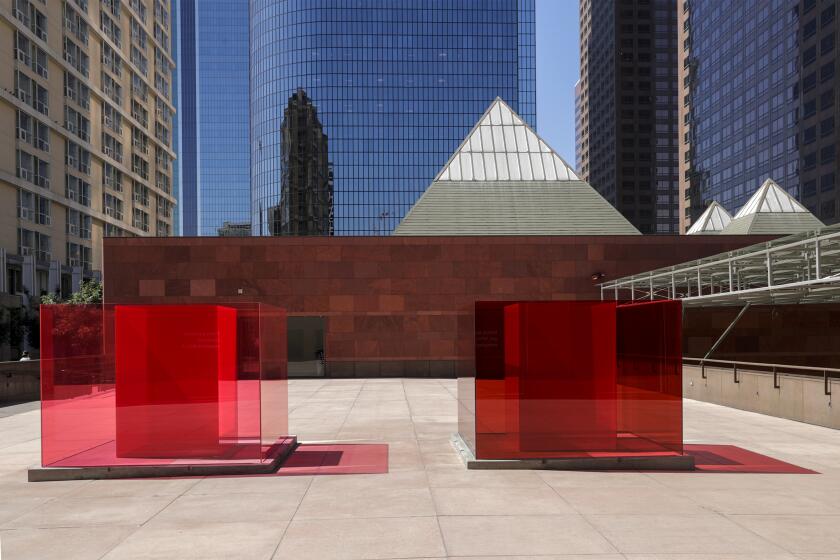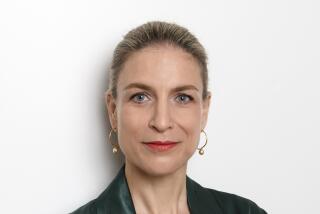MOCA appoints an executive director to co-run the museum
- Share via
The Museum of Contemporary Art has hired Johanna Burton, executive director of the Wexner Center for the Arts at the Ohio State University, to lead MOCA alongside Klaus Biesenbach, who shifts from director to artistic director.
Biesenbach and Burton, whose title will be executive director, will co-run MOCA and both report to board chair Maria Seferian as part of a top-level restructuring.
For the record:
1:22 p.m. Sept. 3, 2021An earlier version of this article cited the wrong year of the Hammer Museum exhibition “Take It or Leave It.” It was staged in 2014, not 2007.
“I’m excited to work closely with Klaus on visioning the next era of MOCA, listening closely to our staff and communities, while bringing the museum’s structures into ever-more vibrant alignment with the museum’s values,” Burton said in the announcement.
Before joining the Wexner, Burton was director and curator of education and public engagement at New York’s New Museum, where she organized the 2017 exhibition “Trigger: Gender as a Tool and a Weapon.” Before that, she was director of the graduate program at Bard College’s Center for Curatorial Studies and associate director for the Whitney Museum of American Art’s Independent Study Program. She guest-curated the 2014 Hammer Museum exhibition “Take It or Leave It.”
That the new executive director is a woman is significant. Since its founding 42 years ago, MOCA has had six directors: Pontus Hultén (1980-1982), Richard Koshalek (1983-1999), Jeremy Strick (1999-2009), Jeffrey Deitch (2010-2013), Philippe Vergne (2014-2018) and Biesenbach (since 2018). All were white men. Four arrived from New York.
Although MOCA has a female-led board with Seferian as chair, Carolyn Powers as president and Heather Podesta as treasurer, the museum has struggled with diversity. In 2018 it canceled a gala fundraiser after protests over the lack of diversity among former gala honorees, all of whom were straight white men. Artist Mark Grotjahn, also white, initially accepted the honor but later declined, citing “a new urgency to change the power dynamic.”
Burton is a step in that direction, said Hammer Director Ann Philbin.
“I’m very happy to see they selected a woman — a first for MOCA and a good partner for Klaus,” she said, adding that although Burton is a “fairly new museum director,” she also “brings a great set of skills to this position — not just executive and managerial skills, but she has stellar curatorial and academic chops as well.”
MOCA’s “artist-centered mission,” Burton said in the announcement, “dovetails with my own commitment to creating platforms that foster artistic innovation and emphasize deep connections to audiences. By pursuing these goals and supporting the efforts of MOCA’s team, I’m looking forward to extending the museum’s legacy while strengthening bonds both within the institution and with the public. “
You read it here first. A new executive director for the Museum of Contemporary Art will be announced, but an email to Times journalists is the real puzzler.
Two directors, each focused on different aspects of the institution, better serve the museum’s mission and its community, MOCA has said. It’s a divide-and-conquer strategy: Biesenbach will assume responsibility for the museum’s artistic vision, overseeing exhibitions, programming and the collections. Burton will run daily management and operations, including finance, advancement, education, communications and human resources. Burton also will steer new initiatives, such as the museum’s IDEA effort, promoting inclusion, diversity, equity and accessibility. Both directors will fundraise.
When MOCA first announced the restructuring in February, however, there was much skepticism among art-world figures that the dual leadership structure could work. Some expressed concern about inevitable conflict. Others pointed out that the division of responsibilities wasn’t so neat and tidy: Biesenbach is artistic director but the curatorial staff will report to Burton. Was Biesenbach’s new role, then, a demotion, they wondered, more like a chief curator, and would the new executive director really be running the museum?
Seferian said that is not the case. The two-pronged leadership structure, she told The Times, is “a natural progression of MOCA’s growth and successes.”
In Thursday’s announcement, Seferian called the restructuring a “new model of distributed leadership” that was “responsive to this moment in our history.”
Of his new role, Biesenbach said he’s “looking forward to focusing my work as artistic director to further expand MOCA being the experimental, innovative, influential and boundary-breaking museum of contemporary art that it has been since its inception and to grow the museum’s reach to broader constituencies, audiences and partners, locally and internationally.”
Burton will be joining a museum that suffered a year-plus COVID-19 closure that postponed and canceled exhibitions. In April several key employees departed, including a senior curator who cited resistance to a diversity initiative and a human resources director who cited a hostile work culture. Revenue in the 2019-20 fiscal year dropped 26%, and membership has decreased 32%, but the museum’s endowment has hit a high point of $170 million.
The museum acquired more than 100 artworks by women and artists of color during the pandemic — an attempt to diversify its permanent collection. It also grew its board this year by seven trustees, including L.A.-based artist Christina Quarles.
MOCA repened its Grand Avenue location to the public June 3. Its postponed special exhibition for 2020, “Pipilotti Rist: Big Heartedness, Be My Neighbor,” will open to the public Sept. 12. The museum will co-present the climate-crisis opera “Sun & Sea” on Oct. 14.
Burton assumes her post on Nov. 1.
Kehinde Wiley and Alison Saar and are among the artists whose work will create a $100-million-plus cultural corridor celebrating Black L.A.
More to Read
The biggest entertainment stories
Get our big stories about Hollywood, film, television, music, arts, culture and more right in your inbox as soon as they publish.
You may occasionally receive promotional content from the Los Angeles Times.












